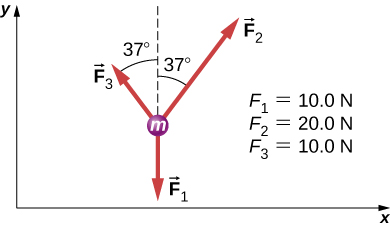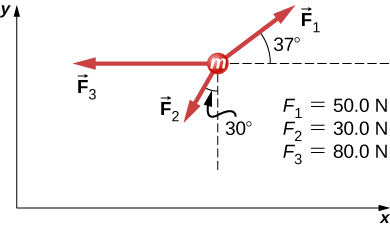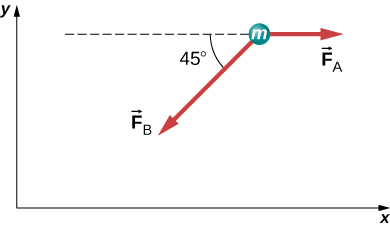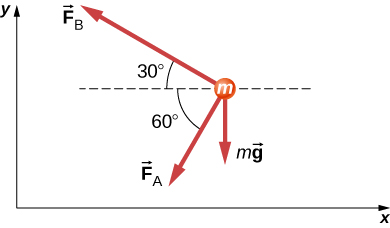| << Chapter < Page | Chapter >> Page > |
Two forces of 25 and 45 N act on an object. Their directions differ by . The resulting acceleration has magnitude of What is the mass of the body?
5.90 kg
A force of 1600 N acts parallel to a ramp to push a 300-kg piano into a moving van. The ramp is inclined at . (a) What is the acceleration of the piano up the ramp? (b) What is the velocity of the piano when it reaches the top if the ramp is 4.0 m long and the piano starts from rest?
Draw a free-body diagram of a diver who has entered the water, moved downward, and is acted on by an upward force due to the water which balances the weight (that is, the diver is suspended).
![]()
For a swimmer who has just jumped off a diving board, assume air resistance is negligible. The swimmer has a mass of 80.0 kg and jumps off a board 10.0 m above the water. Three seconds after entering the water, her downward motion is stopped. What average upward force did the water exert on her?
(a) Find an equation to determine the magnitude of the net force required to stop a car of mass m , given that the initial speed of the car is and the stopping distance is x . (b) Find the magnitude of the net force if the mass of the car is 1050 kg, the initial speed is 40.0 km/h, and the stopping distance is 25.0 m.
a. ; b. 2590 N
A sailboat has a mass of kg and is acted on by a force of N toward the east, while the wind acts behind the sails with a force of N in a direction north of east. Find the magnitude and direction of the resulting acceleration.
Find the acceleration of the body of mass 10.0 kg shown below.

A body of mass 2.0 kg is moving along the x -axis with a speed of 3.0 m/s at the instant represented below. (a) What is the acceleration of the body? (b) What is the body’s velocity 10.0 s later? (c) What is its displacement after 10.0 s?

Force has twice the magnitude of force Find the direction in which the particle accelerates in this figure.

(We add
, because the angle is in quadrant IV.)
Shown below is a body of mass 1.0 kg under the influence of the forces , , and . If the body accelerates to the left at , what are and ?

A force acts on a car of mass m so that the speed v of the car increases with position x as , where k is constant and all quantities are in SI units. Find the force acting on the car as a function of position.
; First, take the derivative of the velocity function to obtain . Then apply Newton’s second law .
A 7.0-N force parallel to an incline is applied to a 1.0-kg crate. The ramp is tilted at and is frictionless. (a) What is the acceleration of the crate? (b) If all other conditions are the same but the ramp has a friction force of 1.9 N, what is the acceleration?
Two boxes, A and B, are at rest. Box A is on level ground, while box B rests on an inclined plane tilted at angle with the horizontal. (a) Write expressions for the normal force acting on each block. (b) Compare the two forces; that is, tell which one is larger or whether they are equal in magnitude. (c) If the angle of incline is , which force is greater?
a. For box A, and ; b. because for , ; c. when

Notification Switch
Would you like to follow the 'University physics volume 1' conversation and receive update notifications?